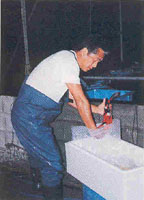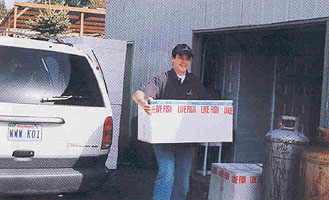"A Journey of Ten Thousand Miles" Every year, thousands of Koi are shipped across the ocean from Japan to America. This is the story of how the average Koi makes its way from a breeder's pond, in the Japanese countryside, to the Koi lover's pond in the United States. Like most Japanese breeders, Karou Miyazaki spawns his Koi around the middle of May and brings those Koi to market in the fall of the same year. At the fall harvest time, the breeder determines which Koi he will keep in hopes of realizing greater potential, and offers the rest for sale. These juvenile Koi that are offered for sale in the fall are commonly referred to as "tosai." Until these tosai have been wintered over, they tend to be quite delicate and must be handled with special care to avoid health problems.
When we purchase in the fall, we have them transported from Niigata to Isawa by truck in aerated 500-gallon vats. Isawa is a town about 100 miles north of Tokyo that is known for its hot spring resorts. Because of its fertile soil, and mineral rich hot springs, Isawa has also become home to a number of Koi breeders. The water in the transport vats is salted at the rate of four pounds per 100 gallons to reduce stress. In addition to the salt, a small amount of acriflavin is added to the water to prevent fungal outbreak during the journey, which can take 6 to 7 hours depending on traffic conditions. Mr. Miyazaki's tosai will spend the next three to four months "wintering over" in the concrete ponds in Isawa. During their sojourn in Isawa, the Koi are kept on a staple diet as the mineral laden waters of Isawa bring out the colors in the Koi without the aid of color enhancers. By early March the Koi are ready to make the trip from Japan to the United States. Four days prior to shipment, the Koi are removed from the general population and placed in an isolation pond to be thoroughly purged. This is probably the most important part of the preparation process. Koi that are improperly purged before shipment will most certainly break down with a myriad of health problems within a week to 10 days after arriving at their destination.
While the Koi are being purged, they are treated with formalin, malachite, and dipterex to eliminated any protozoan or fungal presence that could cause complications during transport. The greatest threat to Koi during transportation is a radical change in temperature. A drastic temperature swing invariably causes a Koi to stress excessively. This can result in an ammonia spike, which can be disastrous in close quarters. In the early morning hours on shipping day, the Koi are packed into plastic bags with fresh water, a little salt, Parazan D, and pure oxygen. The bags are then placed into Styrofoam shipping boxes to ensure that little or no temperature fluctuation will occur during shipment. Thus prepared, the shipment makes its way by truck to Tokyo International Airport, which is a four-hour journey from Isawa. From Tokyo airport, it is about a 9-hour flight to Seattle, Washington, where our staff is waiting alongside the U.S. Customs, and Fish & Wildlife agents, to expedite the shipment's entry into the United States. Once the shipment has been cleared for entry, it is loaded on a truck for the 40-minute trip to our farm in Kenmore.
Upon arrival at our farm, the Koi are immediately transferred to one of our indoor facilities, where the water is heavily aerated and salted (four pounds per 100-gallons). After allowing the Koi to settle down for about eight hours, we perform a general health check on the shipment. We have found that a microscope is an invaluable tool when performing this task. With the pre-shipment preparations in Japan having been carried out properly, it is rare that we find any problems. Under most situations, we try to avoid unnecessary prophylactic medication. We have found that treating specifics is much more efficient than a "shotgun" approach, and that indiscriminate medication serves only to further stress the Koi. After letting the new Koi acclimate for a day or two, we being to slowly change out the salted water and start feeding very lightly. Feeding is an important aspect of Koi health, and Koi can be unduly stressed by feeding too much, too early, or too high a protein content directly after transportation. Before shipping Koi out to their ultimate destination, whether it be New York or California, the whole process of purging and health inspection is repeated to ensure healthy arrival. By the time one of Mr. Miyazaki's tosai arrives at a hobbyist's pond, it has often traveled over 10,000 miles from its place of birth and is usually about one year old. Given the proper care and environment, it can grow to become a Grand Champion...
BACK TO TOP |
||||||||||||||||||
|
|
||||||||||||||||||





